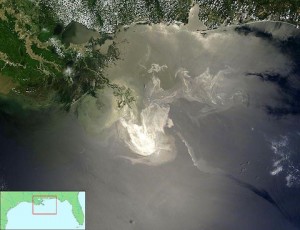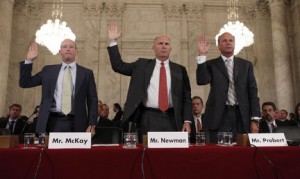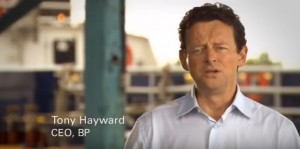3 Blatant Signs That Responsibility Is Lacking
It was May 11, 2010. The U.S. Senate Committee on Energy and Natural Resources had convened a hearing with the leaders of three major companies – BP, TransOcean, and Halliburton – involved in the largest marine oil spill in the history of the petroleum industry.
 Oil from the Deepwater Horizon drilling rig had been gushing into the Gulf of Mexico since April 20, 2010, after an explosion occurred that killed 11 people. Louisiana had already declared a state of emergency due to the threat to the state’s natural resources, as the oil slick approached land.
Oil from the Deepwater Horizon drilling rig had been gushing into the Gulf of Mexico since April 20, 2010, after an explosion occurred that killed 11 people. Louisiana had already declared a state of emergency due to the threat to the state’s natural resources, as the oil slick approached land.
There was no solution in sight to plug the massive oil spill that was filling the Gulf of Mexico at a rate of at least 50,000 barrels a day. And government leaders were beginning to get antsy about the cost of clean up and liability.
BP, the second largest oil company in the world, was at the center of the investigation. Transocean, a Swiss offshore drilling contractor that owned and operated the Deepwater Horizon oil rig, was leasing the rig back to BP. Halliburton was the contractor responsible for cementing the oil well that was more than 18,000 feet below sea level.
The objective of the meeting was to examine the responsibility, financial liability, and penalty provisions of the law related to this disaster.
 Sadly, the executives from each of these billion dollar companies stood there blaming each other.
Sadly, the executives from each of these billion dollar companies stood there blaming each other.
- Halliburton claimed to have met BP’s stated requirements for the cementing task and cited the failure of Transocean’s blowout preventer.
- Transocean’s CEO said the blowout preventer was successfully tested a week before the accident, and blamed BP and Halliburton for the inadequate cementing believed to have led to the explosion.
- BP’s president stated that Transocean, as owner/operator of the drilling rig, was responsible for safety.
No one stepped up to take responsibility. It was lacking everywhere.
As the U.S. President openly stated a few days later:
“I did not appreciate what I considered to be a ridiculous spectacle during the congressional hearings into this matter. You had executives of BP and TransOcean and Halliburton falling over each other to point the finger of blame at somebody else… it is pretty clear that the system failed, and it failed badly.”
And the failures do not stop. The oil continued spilling for a total of 87 days, causing economic and ecological devastation along the Gulf of Mexico coast.
Fast-forward to September 2014, after years of litigation, and a U.S. judge finally made a ruling. He divided blame among the three companies involved in the spill: BP bears 67% of the blame; TransOcean takes 30%; and Halliburton takes 3%. In his comments, the judge stated that BP was primarily responsible for the oil spill because of its “gross negligence and reckless conduct.”
The signs were clear that responsibility was severely lacking.
3 Blatant Signs that Responsibility is Lacking
1) The blame game is the first blatant sign that responsibility is lacking. This was obvious at the U.S. Senate Committee hearing.
2) Another blatant sign that responsibility is lacking is when leaders clearly put profit above all else. Consider this incredible ignorance by the leaders of TransOcean:
On May 13, 2010, only 2 days after standing in front of the U.S Senate Committee, TransOcean filed a claim in a Federal court in Houston, TX indicating their liability should be capped at $26.7 million, based on the American Admiralty Law. Then the very next day, on May 14, 2010, TransOcean announced at a shareholders meeting in Switzerland that the company planned to distribute $1 billion in profit to shareholders.
What were the leaders of TransOcean thinking?
Looking at TransOcean’s six stated values, there appears to be a serious disconnect with at least one value:
Trusted – We will always act with integrity and professionalism, honor our commitments, comply with laws and regulations, respect local cultures, and be fiscally responsible.
There was clearly no sense of accountability to this major disaster, which did not go unnoticed by the U.S. Senate Committee, nor by the thousands impacted by the devastation to the gulf Coast.
3) Then there’s the blatant sign of when a leader clearly lacks self-awareness, even when publicly claiming responsibility.
 The CEO of BP, Tony Hayward, made numerous blunders from the very beginning of this disaster:
The CEO of BP, Tony Hayward, made numerous blunders from the very beginning of this disaster:
- Hayward initially referred to the oil spill as “relatively tiny” in comparison with the “very big ocean.”
- Hayward told the BBC that TransOcean was to blame, saying BP “will be judged not on the basis of an accident that, you know, frankly was not our accident“.
- While the oil spill continued, Hayward caused a major outrage after telling reporters, “There’s no one who wants this over more than I do. I would like my life back.”
- While the oil spill continued, Hayward decided to be featured in an ad campaign aimed at boosting opinion about BP.
- While the oil spill continued, Hayward was seen attending a yacht race with his son, off the British coast, causing much anger in the US.
To cap it all off, it was a poor sign of leadership when the U.S. President made a statement specific to Hayward:
“If he was working for me I’d sack him.”
So, it wasn’t surprising when the BP board decided to replace Tony Hayward, installing Bob Dudley as CEO shortly after the oil spill was finally stopped. But the question remains: has anything changed inside BP? Or TransOcean? Or Halliburton?
In the end, this disaster was a costly experience for BP and the other companies involved. To date, BP alone claims to have spent over $60 billion on clean-up costs, fines, and settlement of lawsuits. That’s an awfully expensive bill that symbolizes a responsibility problem.
A History of Problems
 For BP, the Deepwater Horizon oil spill was not their first major disaster.
For BP, the Deepwater Horizon oil spill was not their first major disaster.
The company actually has one of the worst safety records of any major oil company that operates in the United States. Since the turn of this century alone, BP has been directly involved in several major environmental and safety incidents, including:
- An explosion at BP’s Texas City Refinery in 2005, causing the death of 15 workers and injuring 180 others. This resulted in a record-setting OSHA fine.
- The largest oil spill on Alaska’s North Slope in 2006, with a 5-day leak in the oil transit pipeline (due to corrosion) at Prudhoe Bay. This resulted in a US$25 million civil penalty, the largest per-barrel penalty at that time for an oil spill.
There is clearly a culture of risk-taking at BP, which has proven to pay huge dividends over the years. But when an accompanying sense of responsibility and accountability is lacking, there are significant costs that go beyond paying out money.
This kind of behavior can lead to the demise of major companies, which is what happened to Enron, WorldCom, Global Crossing, Nortel and many others.
The question then for all leaders is: What’s the real cost when responsibility is lacking throughout an organization?
Real responsibility starts at the top and is proven in every day decisions, not just in a crisis.
—————————–
What are other blatant signs that responsibility is lacking?









